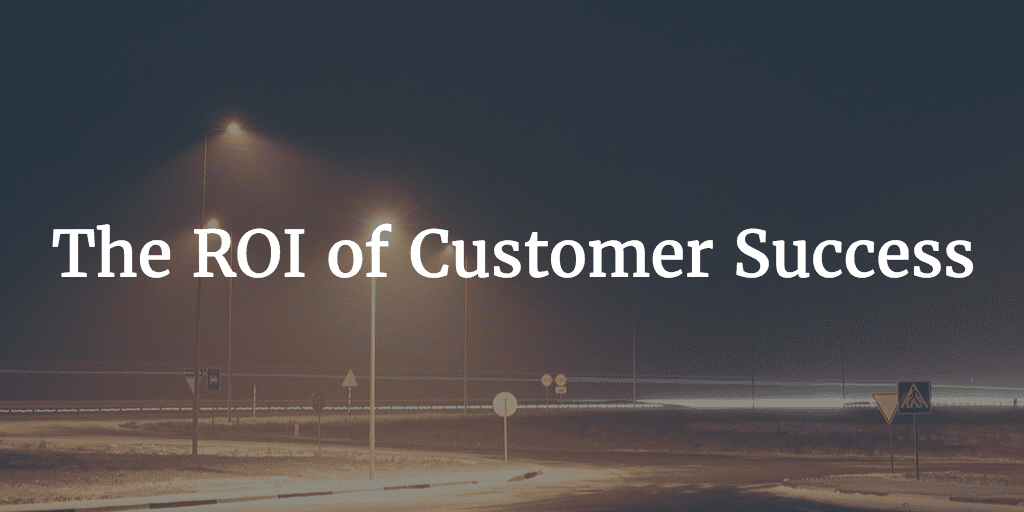Allison Pickens is VP of Customer Success & Business Operations at Gainsight.
The number-one question that keeps most VPs of Customer Success up at night is:
“What’s the ROI of Customer Success?”
This question is challenging to answer for two reasons:
(1) Broad Accountability with Limited Influence
CSM teams are typically held accountable for the gross renewal rate, as well as upsell in many cases.
But we all know that when a customer renews, it’s not just because of the CSM, even if s/he deserves most of the credit. The Product Team ensured adequate product-market fit, the Sales Team originally sold to a customer with the right profile and adequate resources and the Support Team followed up on tickets in a timely way.
Other teams also pave the way for the CSM to upsell his/her customers.
In reality, it takes a village to renew and upsell a customer. Customer Success can’t take full credit.
(2) Broad Influence with Limited Accountability:
At the same time, CSMs influence metrics that they’re not typically held accountable for.
A few examples:
MQLs: When an inbound lead says they “heard great things about your product,” there was a CSM behind the existing customer that spoke with the lead. But formal accountability for MQLs lies with Marketing.
Close rate: When a prospect signs a contract after speaking with a reference, there was a CSM behind that reference-able customer. But formal accountability for the close rate lies with Sales.
Ticket resolution time: When your Support team resolves a ticket quickly, they may in fact be indebted to your CSM team for providing helpful context for the ticket. But formal accountability for ticket resolution time lies with Support.
Bugs rate: When the quality of your product improves, there’s often a CSM in the background that offered feedback to your engineering team. But formal accountability for the incidence of bugs lies with Engineering.
Again, the true ROI of Customer Success isn’t limited to metrics that CSMs are typically held accountable for.
Most companies are aware of Problem #1 – that CSM teams don’t have exclusive influence over the metrics they’re accountable for. That’s why CSM teams typically don’t get full credit for improved renewal rates; we also recognize the Product Team for improving usability, the Services Team for improving the implementation process, etc.
Interestingly, most companies don’t recognize that Problem #1 is equally applicable to departments besides CSM.
- Marketing is held fully accountable for MQL target attainment.
- Sales is held fully accountable for attainment of the new business target.
But as illustrated by the examples listed under Problem #2 above, in reality Marketing and Sales don’t have complete influence over MQLs and new business respectively. Customer Success contributes to both of those metrics.
Non-CSM departments are also subject to Problem #2: they influence metrics that they’re not typically held accountable for. For example, the Sales Team influences time-to-value (and ultimately the gross renewal and upsell rates) by selling to customers who are or are not the right fit. But as long as the Sales Team meets their new business target, “it’s all good.”
A Venn diagram can illustrate Problems #1 and #2. I’ve shown two examples below: one for CSM and one for Sales.
CSMs are held accountable for the Renewal Rate and Upsell metrics, but can’t completely influence them, which is why those metrics are on the border of the Influence circle. They influence Referrals, References, and Product Quality, but not completely, which is why those metrics are on the border of the Influence circle.
And the Sales Team finds itself in an analogous situation:
So why do these problems matter? In the current situation, we have the following consequences:
- If you want to improve a particular metric, it’s not clear which department you should invest in, given that multiple departments influence each metric.
- Relatedly, if you want to quantify the ROI of a given resource (i.e. the prompt of this blog post), you can’t simply look to the metrics that this resource is formally accountable for.
- If you have a feeling that a given department should do additional work to contribute to a metric that they don’t formally own, it’s hard to get them to change their focus.
In the best organizations, accountability and influence coincide.
So what does that ideal organization look like?
Before jumping to my recommended solution, let’s explore two other organizational models that address Problems #1 and #2.
Organizational Model #1: Carve Out Silos
This solution argues that if Customer Success is to be a peer to Sales and other departments, it has to be fully accountable for its own metric – i.e. take full credit and blame for it, even if the team’s influence is limited.
In this world, every department is accountable for one to two key metrics. For example:
- Sales: New Business ARR
- Marketing: MQLs
- Customer Success: Gross Renewal Rate and Upsell ARR
- Support: Ticket Resolution Time
- Services/Onboarding: Project Completion Time, Services Gross Margin
This is what most SaaS businesses look like today. In this model, every department head fights for resources to achieve his/her metric. At Gainsight, we call this model the “Team of Rivals.”
The benefit? Every metric is well-represented in a cross-functional debate.
The downside? There are often significant negative externalities from each department’s actions. For example:
- Support strives for faster resolution time to the detriment of the customer experience, hurting the gross renewal rate that the CSM team is responsible for.
- Customer Success strives to improve the renewal rate, but doesn’t make the effort to convert happy customers into advocates, which is a missed opportunity to drive the Marketing Team’s MQL generation.
- Marketing strives to boost the volume of MQLs to the detriment of the Sales Team’s average selling price.
In this model, the only person who (a) has an incentive to care about all metrics and (b) is capable of minimizing the negative externalities of each team’s effort is the CEO. The CEO spends his/her time prodding each department head to “keep the other department’s goals in mind,” organizing off-sites to alleviate friction between teams, and slogging through cross-functional initiatives.
This is one major reason why being CEO of a typical SaaS company is a very difficult job, and also a reason why many CEOs are hiring a Chief of Staff to do the dirty work.
Organizational Model #2: Make Customer Success the Glue
At Gainsight, we know Solution #1 isn’t the best way to run a company. That’s why we’ve written so much about the role of the CSM in serving as the quarterback – on behalf of your customers – to hold other departments accountable for their role in customer success.
This model takes for granted that other departments – Sales, Marketing, etc. – are largely focused on their own one-to-two metrics and operating in their own silos. The CSM’s role is to prevent the resultant inefficiencies from affecting the customer experience.
In this model, the CSM…
- Ensures that Support Teams are not just driving time to resolution, but also driving toward the right resolution from the customer’s perspective.
- Gives feedback to the Sales Team when they sell to customers that aren’t ready for the product (see our Readiness Risk).
- Works with the Services/Onboarding Team to help overcome any negative sentiment during onboarding and ensure value is delivered (see our Implementation and Sentiment Risks).
- Etc.
The detriments of this model are as follows:
- Your CSMs have to be strong – they’ll be expensive.
- Your head of CS also has to be strong.
- Ideally, non-CSM teams keep customer happiness in mind even when the CSM team isn’t monitoring them. When CSM has to monitor, opportunities to drive customer happiness are inevitably missed.
- Pattern recognition will invariably slip through the cracks. Your CSMs might succeed in tactically resolving cross-functional issues that arise, but they won’t be in a good position to identify patterns that require functional expertise. For example, they may not recognize that a product enhancement would fix some of the issues they’re working through precisely because they’re not product experts.
Organizational Model #3: Align Accountability with Influence
Here’s the model I recommend: hold departments accountable for all metrics they influence, and only those.
Let’s take a look at the CSM department as an example. CSMs drive New Business by generating new leads and by providing sales references and customer case studies that improve close rates. Once you analyze your close rates by lead source and how those change when a sales reference or case study is used, you can calculate the incremental New Business ARR resulting from the CSM team’s advocacy efforts.
This means you can assign a New Business target to the CSM team.
Because this framework assigns a value to CSMs’ influence of a metric that they are not normally held accountable for, the framework allows us to return to the question initially posed in this email: what’s the ROI of Customer Success?
The ROI is equal to the sum of the dollar-metrics that the CSM team influences. Add the Incremental New Business ARR described above to the Incremental ARR due to CSM activities influencing the renewal rate and the CSM activities influencing upsell, as described here:
The hardest part will be determining the multipliers in the chart above. But once your organization is aligned on those, you can calculate the dollar impact of your CSM team using a dashboard.
Imagine that: Every week, reporting on the dollar impact of your CSM team.
Stay tuned: I’ll write in more detail about calculating the ROI of CSM in the coming weeks. For example, given that a saved renewal preserves a potentially perpetual annuity stream (in the form of future renewals), you could calculate the ROI of CSM efforts in terms of Lifetime Value (LTV) rather than ARR. More to come.
So, can you align Accountability and Influence for every department, not just for CSM?
In theory, every department should have a target for each metric it influences. In the table below, I’ve indicated which departments – in principle – should probably have a target (“T”) for each financial metric. (Taking this to the extreme, you could even argue that every cell in the table should contain a “T.”)
For example, just as you can assign a dollar value to a sales reference from a CSM (in terms of Incremental New Business ARR), you can assign a dollar value to a support ticket closed within 24 hours (in terms of Incremental Renewed ARR).
We haven’t implemented this broad-based target system at Gainsight. But we know that SaaS companies need a better way of aligning Accountability and Influence. I’ll post more on this topic in the future.
To learn about processes that you can set up for your CSM team and other departments, check the Business Processes section of Gainsight Go, check out the Gainsight Vault, or contact your CSM. You can also send questions or feedback to Allison at apickens@gainsight.com. Follow her blog posts on Twitter at @PickensAllison.








